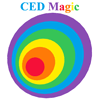
 |
Search | FAQ | US Titles | UK Titles | Memories | VaporWare | Digest | |||||||
| GuestBook | Classified | Chat | Products | Featured | Technical | Museum | ||||||||
| Downloads | Production | Fanfares | Music | Misc | Related | Contact | ||||||||
| CED Digest Vol. 3 No. 26 • 6/27/1998 | ||||||||||||||
Date: Mon, 22 Jun 1998 20:26:14 -0700 From: Neil Wagner To: *CED Digest <ceds@teleport.com> Subject: Videodisc History Part 28 >From the February 1984 issue of Popular Science - VIDEO TEACHERS A new RCA interactive videodisc player offers much more than just movies. It plays games, lets you select scenes from its repertoire, and even functions as a teacher. (Yes, it also gives you a test.) And an unusual future probably awaits it. by William J. Hawkins I took a deep breath and put down my money. A moment later, I heard the announcer say, "They're off," and the race track in front of me filled with the pounding hooves of thoroughbred horses. Number Six had won the last time, and my bankroll for the day said that he'd do it again. But a few minutes later, I was thinking how well Number Six would do as a bottle of glue. Time to go home? No, time to turn off the TV and call it a night. Fortunately for my bank account, I was using RCA's first interactive videodisc, "A Week at the Races," and its new SelectaVision 400 interactive-videodisc player. The disc is merely a "high-tech" game you play. But as I found out, the idea of interactive-disc playing can involve far more than just games and home entertainment. RCA's disc player is similar to past models: Pop in a videodisc, and you see its contents--from movies to concerts --on the screen in color. If the unit is connected to your hi-fi, you hear the sound in stereo. But this new interac- tive model allows you to choose particular sections for viewing and to specify the order in which they will be shown. Those scenes and the order in which you see them can be dif- ferent each time you use the disc. You make your selections by pressing buttons on an infra- red remote control. The numbers you choose represent specific "bands" encoded on the disc. In its simplest form, each band number may represent a particular song on a concert disc: Choose band number three on a Luciano Pavarotti disc, for instance, and in moments he's ready to sing "Recondita armonia." For other discs, the technology provides a whole new way of displaying information. For example, another disc I tried was CBS's "A Walk through the Universe." I began at band 33, which automatically froze a frame displaying the menu of major topics. I was curious about the origin of the universe, so I tapped "20" into the remote control. The main menu disappeared, and within a few seconds I was told that there are two theories--big-bang and steady-state--and that I could learn about either one by selec- ting the appropriate band from another menu that now appeared on the screen. I chose one, and soon I was watching a presentation of animated concepts, drawings, and interviews with leading scientists. Was I learning anything? The disc now began to ask me questions about what I'd seen; it gave me a test. You answer questions by tapping in band numbers that move you to other areas of the disc. There, you're told whether you're right or wrong, and why. Finally, the disc showed another display of suggested band numbers to enter for an automatic sequence of presentations. I could, for instance, have created a debate between the big- bang and steady-state theorists, or have plotted my own per- sonal course through specific planets of the universe. That ability to show individualized, one-on-one material could make future videodiscs the most powerful "video teachers" since the personal computer. [This article will be continued in the next issue of CED Digest.] -- Neil - nw1@gte.net
Previous Digest | Next Digest | Volume 3 Index | CED Magic Home